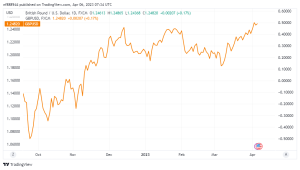The GBPUSD pair is under selling pressure for the second day in a row on Thursday, but it manages to stay above the 1.2400 line during the Asian session. The US Dollar (USD) extends its overnight recovery move from its lowest level since early February. And appears to be a significant component placing some downward pressure on the main currency.
Fears of a recession weigh on investors’ attitude, benefiting the safe-haven Greenback.
The arrival of lower US macro data indicated a slowdown of economic development. And reignited recession worries. As a result, investors’ desire for risky assets is dampened, benefiting the safe-haven Greenback.
However, rising recognition that the Federal Reserve (Fed) is nearing the end of its inflation-fighting interest rate rises may deter USD bulls from making aggressive wagers and assist limit the downside for the USD. In reality, markets are presently pricing in a 25 basis point increase at the next FOMC monetary policy meeting in May. With the prospect of rate decreases by year’s end.
The dismal US ADP data on Wednesday boosted bets, showing that private-sector firms gained 145K jobs. In March, compared to 200K expected and the prior month’s upwardly revised number of 261 K. Furthermore, the ISM Services PMI showed a slowing in growth in March. As well as a slowing in its Employment sub-index, suggesting that the Fed’s attempts to chill the labor market may be having an effect.
Fed rate-hike halt might restrict the USD and aid limit losses for the major.
The report supports expectations for a pause in Fed rate hikes and brings US Treasury bond rates back to recent highs. Traders, on the other hand, appear to be easing their USD negative bets ahead of the release of the US monthly employment data, known colloquially as the NFP report, on Friday.
The British Pound, on the other hand, is under pressure due to conflicting signals from Bank of England (BoE) officials over the path of future rate hikes. Indeed, BoE MPC member Silvana Tenreyro pushed on Tuesday for rates to be reduced sooner than expected since the absence of cost-push shocks would drive inflation well below goal. In contrast, the Bank of England’s Chief Economist Huw Pill stated that action is still required in assessing inflation predictions. And that the onus remains on policy is delivered to complete the job. This puts additional strain on the pair.
GBPUSD Technical Outlook
Technically, any following decline is to find solid support near the 1.2400 resistance breakpoint. Which has now been converted to support.
The aforementioned handle should serve as a critical target for intraday traders. And if violated, might trigger some technical selling, dragging the GBPUSD pair towards the 1.2340-1.2335 zone.
This is followed by the 1.2300 round-figure level and the weekly low. Which is at 1.2275. A break below the latter will indicate that the pair has built a near-term top. And will pave the way for a more significant corrective downturn.

On the other hand, the level of 1.2500 appears to be acting as an immediate strong obstacle. Some follow-buying has the potential to push the GBPUSD pair beyond the 1.2550. Intermediate resistance level, towards 1.25. regaining the 1.2600 round number on the way to the May 2022 swing high. Which is expected to be around the 1.2655-1.2660 range.









